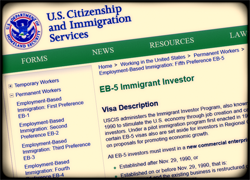As we reported in an earlier blog, the staff of USCIS rejected a questionable set of immigrant investor applications, revoking some earlier decisions in the process, and brought down on the agency a court case filed by some of the biggest guns in the EB-5 business.
Acting swiftly, a federal district court judge sitting in California totally rejected the applicants' attempt to get a temporary restraining order against USCIS, though other elements of the case continue to be litigated.

The EB-5 program is a two-step operation, in which investors (and all their immediate family members) get conditional residence papers and work authorizations while their half-million-dollar investments are being made. If the process works satisfactorily, at the end of two years the conditional status is converted to permanent resident alien (or green card) status in another USCIS procedure. Each of the half-million investments is supposed to create, directly or indirectly, 10 full-time jobs.
This case is interesting for a bunch of reasons:
- The staff decision was against a specific set of applications, though the USCIS leadership is avidly for the program, generally;
- The staff not only decided against some of the half-million-dollar bids for green cards, it decided to revoke an earlier set of positive decisions on similar applications;
- Losing at the TRO level is one of the major players in the business, the London-based American Life Development Company;
- The losing immigration law firm is also a major player, that of Miami's Ira Kurzban;
- The case revolves around "tenant occupancy", the bizarre notion, sometimes accepted by USCIS, that if you build a building and some other company moves in and hires some people, the occupants' new employees should be counted as jobs created by the building investors;
- The plaintiffs demanded in their brief that USCIS should always approve this type of application in the future (thus pushing their luck in this non-lawyer's eyes); and, best of all
- The judge, a Clinton appointee, ruled that the proclaimed danger of deportation of the investors who seem to be losing their case, argued by their lawyers, is too remote a possibility to be considered.
The last point, which could be considered a slap at the lax immigration enforcement policies of the Obama administration, dealt with the revocations of eight applications that had been approved earlier by USCIS, with some or all of the investors moving to the United States on the conditional cards. Judge Christina Snyder ruled that:
Undoubtedly, plaintiffs' deportation from this country would cause them irreparable harm, but there are no pending removal proceedings against plaintiffs here. Therefore, the risk of deportation is speculative at present.
That statement stands in sharp contrast to many of the comments routinely made by the more-migration people that whenever deportation is conceivable (no matter how unlikely) it is always regarded as a looming disaster.
The case is Courtney Carlsson, et al. v. USCIS, et al., and it is in the Central District of California. Users of the federal courts' electronic documents system, PACER, can find it at 2:12-cv-07893-CAS-AGR, with the TRO decision being document 11. Non-PACER users can read the same document with annotations by Joe Whalen, an EB-5 consultant.
The case is far from over, and among the possible outcomes are these: Judge Snyder may rule in favor of the plaintiffs on one or more of the remaining issues; her decision(s) may be overturned by the generally pro-migrant Ninth Circuit; or, most worrisome, the USCIS front office may undermine its own staff, and the federal lawyers, by settling with the investors. We will see.


